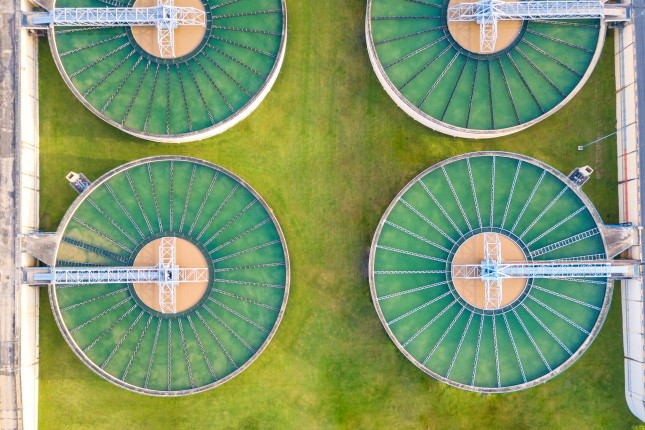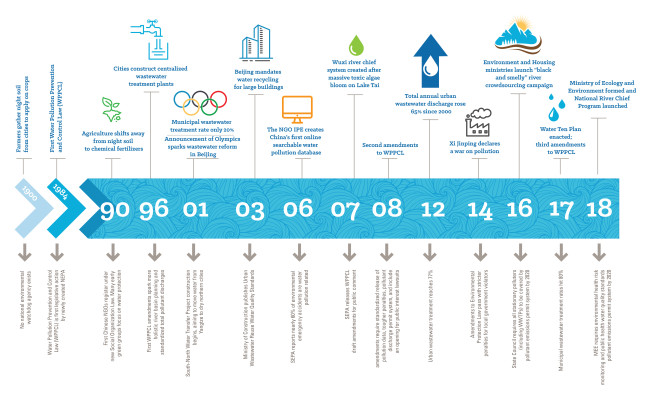-
Nine Dragons Rule the Waters: Closing the Loop on China’s Water Pollution (Report Launch)

The Chinese government is fighting a war on pollution on multiple fronts to protect its air, water, and soil. Despite passage of the stringent Water Ten Plan in 2015, water quality still has not met anticipated targets in one-third of the country. But one Chinese pollution control success story was Beijing’s investments in municipal wastewater treatment plants in the run up to the 2008 Olympics.
In 2001, when Beijing was chosen to host the 2008 Summer Olympics, untreated wastewater and agricultural runoff had turned many of China’s rivers black and large lakes green with toxic algae blooms. Strikingly, municipal wastewater treatment rates across the country rose from 22 to 70 percent between 2001 and 2008. By investing in pollution control, Beijing prepared for the international exposure the Olympics bring and managed to limit air and water pollution before the Olympic Games began.
Yet Beijing’s 2008 environmental success was not complete. Despite wastewater treatment regulations, nearly 80 percent of China’s sludge went untreated, polluting soil and water and making it a growing source of methane emissions—a potent greenhouse gas. China’s mountains of municipal and industrial sludge and lack of rural wastewater treatment sparked Chinese President Xi Jinping to declare wastewater a major part of his “war on pollution” in 2018.
Treating wastewater and sludge can be expensive. Former Wilson Center Schwarzman Fellow Danielle Neighbour has authored a new InsightOut report “Closing the Loop” detailing how China can learn from New York, Washington, D.C., and Singapore by tapping three marketable resources from sludge to advance its wastewater and carbon reduction targets. Specifically, Chinese wastewater plants can: (1) capture methane to generate low-carbon power, (2) treat sludge digestate to make compost, and (3) recycle the wastewater to meet multiple municipal and industrial water needs.
Methane and Digestate: Low-cost Solutions
More than 25 times more powerful than carbon dioxide, methane is an abundant greenhouse gas that contributes more than one-third of today’s anthropogenic climate warming. The wastewater sector accounts for 10 percent of global methane emissions, and China is responsible for one-quarter of these emissions. Wastewater treatment plants (WWTPs) can capture methane through anaerobic digestion (AD)—where microorganisms break down organic material in sludge in a digester tank. Methane is a natural gas and can be burned to generate power. Since wastewater treatment plants account for an average of 30 to 40 percent of a city’s total electricity use, generating power from methane for on-site use can benefit energy-intensive wastewater treatment plants.
All 14 wastewater treatment plants in New York City capture wastewater methane using anaerobic digestion. At Newton Creek, the largest treatment facility in New York City, methane will soon be converted into pipeline-quality renewable natural gas (RNG) to be purchased and processed by National Grid. The project will eventually produce enough RNG to heat 5,200 homes and reduce greenhouse gas emissions by 90,000 MtCO2 equivalent (akin to removing 19,000 cars from the road).
Digestate (a.k.a. biosolids) produced in the AD process can be further dried and treated to be sold as organic compost, preventing the potentially toxic solids from being dumped into landfills and waterways. Rich in nitrogen and phosphorus, digestate provides nutrients for soil. The fertilizer also mitigates greenhouse gas emissions. Using digestate has a notable climate benefit—after two years of biosolids application, digestate-applied soil absorbs carbon at a rate between 37 and 84 percent more than degraded urban soils, according to a Virginia Tech study.
Washington, D.C.’s Blue Plains Treatment Plant, the largest advanced wastewater treatment system in the world, disinfects biosolids and produces high-quality fertilizer used in Washington D.C., Pennsylvania, Maryland, and Virginia sold under the brand name Bloom. Its customers include landscapers, farmers, and homeowners. Even the National Park Service uses Bloom as fertilizer on the National Mall.
Recycled Wastewater: Quenching Thirsty Cities
Recycled wastewater provides an alternative tap for a water-scarce China, as it can recharge aquifers, irrigate agriculture, and supply water to local industries. China’s available per capita water supply is one-fourth the world’s average yet China only reclaims approximately four percent of its wastewater.
For a successful recycled water story, the Chinese should look no further than Singapore. Singapore’s Public Utilities Board has branded its reuse water as NEWater, currently supplying 40 percent of Singapore’s water needs to reduce their reliance on purchased water from Malaysia. Treated via microfiltration, RO, and UV disinfection, NEWater supplies both potable water for drinking and washing as well as non-potable water for industrial usage.
Climate Resiliency
Like many cities in the United States, during extreme rain and hurricanes many of China’s combined sewer systems and wastewater treatment infrastructure release sewage that subsequently floods streets and contaminates drinking water sources.
To increase the climate resiliency of wastewater systems, Chinese cities can follow New York City’s lead by implementing green infrastructure. Through recent sustainability and resiliency plans, New York City is utilizing natural catchment areas (like rain gardens), expanded park space, and street trees, as well as permeable pavements, to reduce the amount of stormwater entering drains. Because more than 70 percent of NYC’s land area is covered by impervious surfaces, the NYC Department of Environmental Protection has sought to prevent paving natural drainage corridors through the Bluebelt program. In place since the 1990s, the Bluebelt program maintains and expands natural stormwater conveyors, like streams and wetlands. These efforts are comparable to China’s Sponge City initiative that the central government launched in 2015 to build out green infrastructure to reduce urban flood risks.
Potential for a Closed-loop Future
While Chinese cities can profit from methane capture, digestate use, water recycling, and measures to increase climate resiliency, economic challenges make implementation difficult. China’s treatment plants often operate at loss and managers are hesitant to invest in long return-on-investment projects. Additionally, finding customers for wastewater byproducts is difficult in China’s economic model. Beijing policymakers could set higher water prices and increase subsidies to raise capital for water utilities to implement methane capture. Cities can also leverage existing policies to create demand for wastewater methane, digestate, and recycled water, enabling China’s wastewater sector to reduce greenhouse gas emissions, remediate soil, and increase water security.
The economic and political challenges to make any of these changes are significant. However, China’s imperative to wastewater reform is clear: landfills are overflowing, freshwater resources are being depleted, and air, soil, and water pollution are worsening. While wastewater currently contributes to these problems, it can also serve as the solution.
As eyes turn to the Beijing 2022 Winter Olympics, China’s environment will once again be open for international inspection. The successes and shortcomings of the “war on pollution” will be evident.
Karen Mancl is a Professor of Food, Agricultural and Biological Engineering at The Ohio State University and Director of the OSU Soil Environment Technology Learning Lab. In 2020, she has been working as a research assistant in the Woodrow Wilson’s China Environment Forum. She holds a PhD in Water Resources from Iowa State University and an MA in East Asian Studies and an MA in Public Policy from Ohio State University.
Richard Liu was a China Environment Forum research intern in the fall of 2019 and is currently a research intern with the Wilson Center’s Serious Games Initiative. He studies economics at Indiana University.
Sources: Atmospheric Environment, Congressional Research Service, DC Water, Frontiers of Sustainable Food, Global Methane Initiative, Global Water Forum, Journal of Environmental Sciences, Land Use Policy, NASA, New York City Department of Environmental Protection, Olympic News, Politico, Reuters, Singapore’s National Water Agency, South China Morning Post, U.S. EPA, World Bank, Xinhua News Agency
Lead Photo Credit: Wastewater treatment plant on Shutterstock.com, All Rights Reserved.
 A Publication of the Stimson Center.
A Publication of the Stimson Center.




